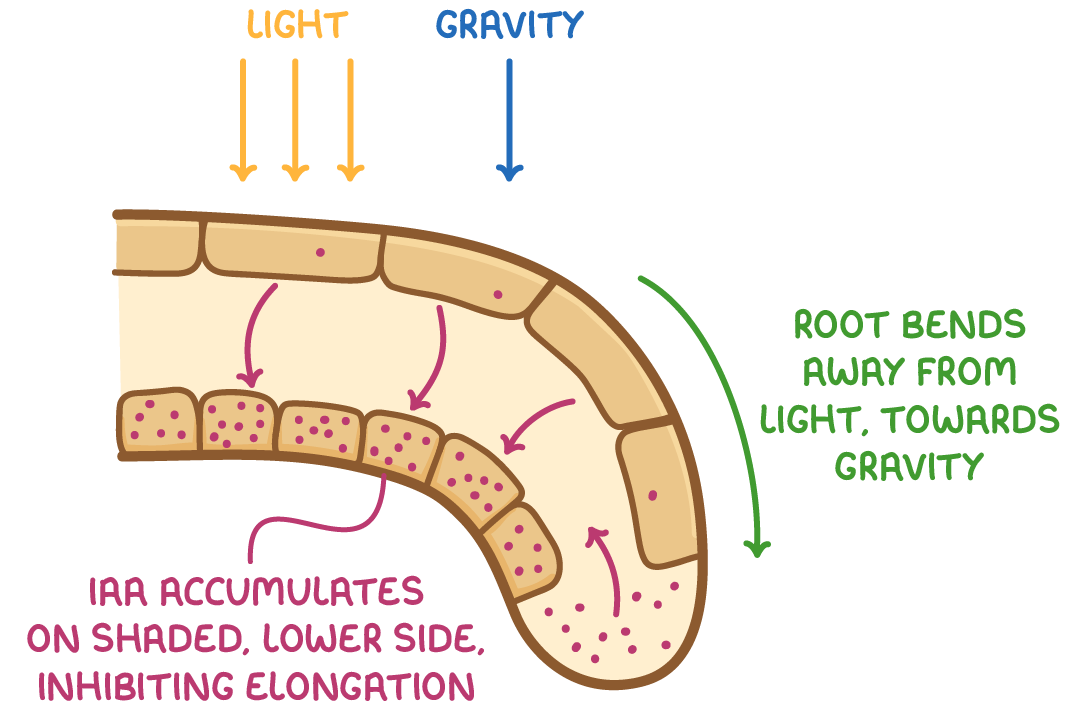Plant Hormones
This lesson covers:
- What plant growth factors are
- The stimuli that trigger plant responses
- The role of IAA in phototropism and gravitropism
- How IAA controls growth by elongation
Plant growth factors
Plant growth factors, sometimes called plant hormones or plant growth regulators, are chemicals that influence plant development mainly by modulating cell elongation and division.
Differences between plant and animal hormones:
- Plant hormones usually act locally at the site of production, while animal hormones usually act on distant organs.
- Plant hormones are produced in a variety of tissues throughout the plant, while animal hormones are produced in specialised cells within glands.
External stimuli that trigger plant responses
Plants have evolved to respond to environmental cues with precise growth movements using plant hormones. The main stimuli they respond to are light, gravity, and water.
They do this through tropisms such as:
- Phototropism - This is directional growth of parts of the plant towards or away from light.
- Gravitropism - This is directional growth of parts of the plant towards or away from the gravitational pull.
- Hydrotropism - This is directional growth of parts of the plant towards or away from moisture.
These tropic responses are critical for plant survival, enabling them to optimise photosynthesis, anchor themselves, and access water and nutrients efficiently.
For instance, positive hydrotropism in the roots is beneficial for plants as it allows the roots to absorb more water, which is an essential medium for transport and a key reactant in photosynthesis.
The role of IAA in tropisms
Auxins, particularly indoleacetic acid (IAA), are crucial plant growth factors that can stimulate, or inhibit, cell elongation. This influences many aspects of growth including elongation of roots and shoots.
Auxins like IAA are synthesised in the growing tips (meristems) of shoots and roots, where the cells are dividing. IAA plays a central role in directing plant responses to light (phototropism) and gravity (gravitropism).
IAA simulates cell elongation in plant shoots, but inhibits cell elongation in plant roots.
Positive phototropism in plant shoots

Control of positive phototropism in shoots:
- IAA is produced in cells in the tip of the plant shoot.
- IAA is transported down the plant shoot.
- Light stimulates IAA to move from the light side of the shoot to the shaded side.
- IAA becomes concentrated and stimulates more cell elongation on the shaded side of the shoot.
- The shoot bends towards the light.
Negative phototropism and positive gravitropism in plant roots

Control of negative phototropism and positive gravitropism in plant roots:
- IAA is produced in cells in the tip of the plant root.
- IAA is transported along the plant root.
- Any light available stimulates IAA to move from the light side of the root to the shaded side.
- Gravity also pulls IAA from the upper side of the root to the lower side of the root.
- IAA becomes concentrated and inhibits cell elongation in the lower, shaded side of the root.
- The root bends away from any available light and downwards towards the pull of gravity.
The role of IAA in shoot elongation
Auxins like IAA play a key role in shoot growth via cell elongation.
This occurs as follows:
- Auxin binds to the cell-surface membrane.
- Hydrogen ions are actively transported from the cytoplasm into the cell wall.
- The cell wall becomes more plastic.
- Cells elongate and the plant grows.